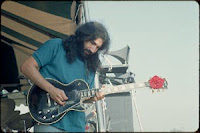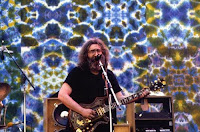Friday, August 23, 1968
Shrine Auditorium – Los Angeles, CA
Soundboard Recording
Perhaps similar to many Deadheads, I spend the bulk of my listening time on shows from the 70’s and 80’s. I get back to the 60’s less frequently, and whenever I do, it strikes me that the shows from that decade are made up more purely of the essential power that would slowly diffuse into all the years that follow. It’s like standing close to the furnace within a power plant that, in turn, powers an entire city. This close, the source itself overpowers anything else, demands your attention. It’s at once frightening and unbelievably awesome at the same time. Put another way, the 60’s were the Grateful Dead’s big bang, and the resulting years were the slow expansion and formation of a glorious universe born out of that supremely powerful moment.
60’s Grateful Dead shows tend to have the opposite problem to that found in the 80’s, but it leads to the same challenge. In the 60’s, there were virtually no subpar shows. And while it means you can stick your hand in the jar and almost always come out with a tasty bit of candy, knowing which piece to grab first can still be a struggle. Picking 60’s shows for the blog has been my greatest challenge thus far for just these reasons.
Here, I will share a no-brainer pick from 1968. Parts this show have appropriately turned up as bonus material on the Golden Road Box Set copy of Anthem Of The Sun , and it is truly a must for all collectors. I had the pleasure of writing the review of 08/23/68 for the now out of print Deadhead’s Taping Addendum. Here is that review:
 August 1968. Always known as an amazing time of an amazing year. This entire show is, without a doubt, a knockout. So much good stuff all over. But what happens from Alligator on is beyond imagination. It takes the date to another level, leaving everything played before it somehow only "great."
August 1968. Always known as an amazing time of an amazing year. This entire show is, without a doubt, a knockout. So much good stuff all over. But what happens from Alligator on is beyond imagination. It takes the date to another level, leaving everything played before it somehow only "great."The Other One blazes with that white-hot freight train intensity that typifies 1968 Dead. But as the show moves along, the true colors of this period begin to seep out from cracks in the skin of the flames. Dark Star is pushing ever closer to its destination of late February 1969. There is a wonderfully gooey passage where Jerry rides his volume knob up and down. Throughout the song you can hear many of the themes that would become rock-solid threads in the fabric of Dark Stars to come. They move into "St. Stephen," and it is most notable for the absence of crowd eruption that its first two notes would elicit in the years to come. It's neat to ponder the youth of the song here in August 1968. This is one of the first ten performances of that tune.
The Eleven is a tidal wave of power. Phil's ability to crunch out note after note, pile-driving energy into your spine, is colossal. The song spins wagon wheels of music slowly over each other. Knots are being tied and untied. Threads ignite and burn like wicks rushing toward dynamite. The drummers begin to snake into one another while Jerry starts to find small themes that pull him out and over the scene. Seconds before the tape cut, it becomes clear that Death Don't Have No Mercy is coming next. Nonetheless, the cut strikes like a city-wide power outage. Though the hint of Death Don't is there, the final decent out of The Eleven is lost. The only saving grace is that none of Death Don't itself is really missing. The tape picks back up at what seems like the logical start of the song.
Soulful darkness pervades Death Don't Have No Mercy as usual. There is a great bonding tie-in when Jerry again rides the volume knob in the same sticky liquid waves he found in Dark Star. It comes in the verse after his solo and it's very brief. But it's this sort of thing that makes the song all the better.
 A twisted image crowds my mind at the start of Alligator. I can't shake the vision of Pigpen telling his story in the song to a group of boys and girls in the kids' section of the local library on a Saturday afternoon. It's odd, and in the first moments of the Drums that comes after his last lines it is swept away. The drummers reach directly into their tribal revival rhythms, joined a few minutes later by Jerry. In a few more minutes the entire band is crashing back into the Alligator jam. It is most pronounced by its lyrical quality. Jerry soars over wildly joyful lines that continually toy with the Mountain Jam. This lends a perfect color to the white-hot blaze of energy - warm yellow and green washing into an electric sea of light. Jerry is breaking the membrane that holds the band on the ground. Without pausing for breath, they bound into Caution.
A twisted image crowds my mind at the start of Alligator. I can't shake the vision of Pigpen telling his story in the song to a group of boys and girls in the kids' section of the local library on a Saturday afternoon. It's odd, and in the first moments of the Drums that comes after his last lines it is swept away. The drummers reach directly into their tribal revival rhythms, joined a few minutes later by Jerry. In a few more minutes the entire band is crashing back into the Alligator jam. It is most pronounced by its lyrical quality. Jerry soars over wildly joyful lines that continually toy with the Mountain Jam. This lends a perfect color to the white-hot blaze of energy - warm yellow and green washing into an electric sea of light. Jerry is breaking the membrane that holds the band on the ground. Without pausing for breath, they bound into Caution.The tide rises and dark blue-black water churns from depths untouched by sunlight. A mild feedback courses over the drums revealing for a moment the true source of the black waters far out above the stars. Pigpen gives the verse, and the call/response between band mates of "all you need" is nicely delivered and heightened by the strong panning of each voice in the stereo mix. This is followed by a dive into Feedback. The sky is peeled back to reveal a home in the back-lit canopy of stars and moons. Music dissolves into cosmic voice and song. The comfort of this space is undeniable. Objects pass around you fast and slow, strange yet familiar. It's as if in Feedback the band manages, with its combined effort, to strum some inner instrument that runs its strings though each of our bodies. It flashes brighter, then is formed into more lyrical bliss by Jerry for a minute or so, the band roaring and moaning beneath him. Caution comes back out of the dark and charges ahead like a beast unchained. But the drone of the inner instrument proves too strong. It pours back into the foreground like sheeting rain pushed on the wind. Somehow, order finds a foothold again in Caution-like sounds. This back and forth between Feedback and Caution is amazing; so much explained in a place so confusing. Then, as if mildly amused by the attempts of order being placed on it, the inner instrument washes everything off the table and leaves the endless void of true space in its wake. Shimmering lights and pulsating globes consume all.
When the reality of the Shrine Auditorium returns with the clapping of hands, it is the most pathetic of attempts at trickery. Surely we have just been snatched out of true reality back into the dreams of daily life - the glimpse of the real world receding on feathered memories that cannot be forgotten.
08/23/68 SBD etree source info
08/23/68 SBD Stream



























